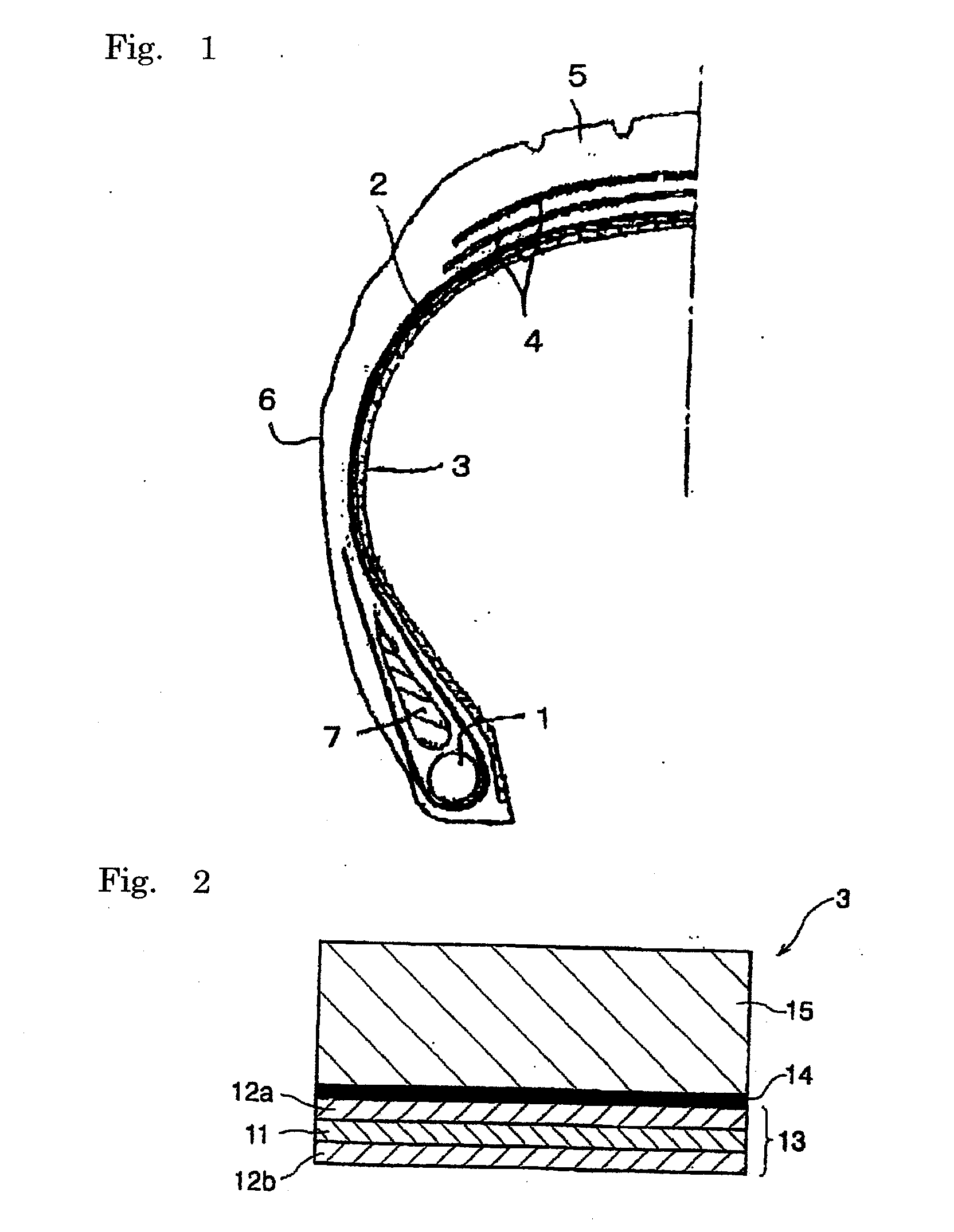Pneumatic tire
a pneumatic tire and tire body technology, applied in the field of pneumatic tires, can solve the problems of reduced rubber strength in unvulcanized condition, limited amount of butyl-based rubber which can be used, and exposed cords at the inner face of the tire tend to be exposed at the surface, etc., to achieve excellent gas barrier property and flexibility, excellent average peel strength, and excellent driving performan
- Summary
- Abstract
- Description
- Claims
- Application Information
AI Technical Summary
Benefits of technology
Problems solved by technology
Method used
Image
Examples
preparation example 1 preparation
of a Modified Ethylene-Vinyl Alcohol Copolymer
[0119]Into a pressure-resistant reactor, 2 parts by mass of an ethylene-vinyl alcohol copolymer having a content of ethylene of 44% by mole and a degree of saponification of 99.9% by mole (MFR: 5.5 g / 10 minutes at 190° C. under a load of 21.1 N) and 8 parts by mass of N-methyl-2-pyrrolidone were placed, and the ethylene-vinyl alcohol copolymer was completely dissolved by stirring under heating at 120° C. for 2 hours. To the obtained solution, 0.4 parts by mass of epoxypropane as the epoxy compound was added, and the resultant mixture was heated at 160° C. for 4 hours. After the heating was completed, the reaction product was separated as precipitates by adding the reaction mixture into 100 parts by mass of distilled water and washed with a great amount of distilled water to sufficiently remove N-methyl-2-pyrrolidone and the unreacted epoxypropane, and a modified ethylene-vinyl alcohol copolymer was obtained. The obtained modified ethylen...
preparation example 2 preparation
of a Three-Layered Film
[0121]Using the modified EVOH obtained in Preparation Example 1 and a thermoplastic polyurethane (manufactured by KURARAY Co., Ltd.; KURAMIRON 3190) as the elastomer, a three-layered film (a layer of the thermoplastic polyurethane / a layer of the modified EVOH / a layer of the thermoplastic polyurethane) was prepared by coextrusion under the following condition of molding using an apparatus for extruding two types of materials to form three layers. The layer of the modified EVOH and the layers of the thermoplastic polyurethane had the same thickness of 20 μm.
[0122]Condition of molding by extrusion was as follows:
[0123]Construction of layers:[0124]a layer of the thermoplastic polyurethane / a layer of the modified EVOH / a layer of the thermoplastic polyurethane (the thickness: 20 / 20 / 20, the unit: μm)
[0125]Temperature of extrusion of the resins[0126]C1 / C2 / C3 / die=170 / 170 / 220 / 220° C.
[0127]Type of the extruder for the resins[0128]thermoplastic polyurethane:[0129]25 mmφ e...
preparation example 3
Preparation of a Layer of an Unvulcanized Rubbery Elastomer
[0137]A rubber composition was prepared in accordance with the following formulation, and a sheet of an unvulcanized rubbery elastomer having a thickness of 500 μm was prepared.
Rubber composition (the unit for the components: part by mass)natural rubber30Br-IIR (manufactured by JSR Co., Ltd.; BROMOBUTYL702244)GPF carbon black (manufactured by ASAHI CARBON60Co., Ltd.; #55)SUNPAR 2280 (manufactured by NIPPON SUN7SEKIYU Co., Ltd.)stearic acid (manufactured by ASAHI DENKA1KOGYO Co., Ltd.)vulcanization accelerator (manufactured by OUCHI1.3SHINKO KAGAKU KOGYO Co., Ltd.; NOCCELORDM)zinc oxide (manufactured by HAKUSUI KAGAKU3KOGYO Co., Ltd.)sulfur (manufactured by KARUIZAWA SEIRENSHO0.5Co., Ltd.)
PUM
| Property | Measurement | Unit |
|---|---|---|
| Temperature | aaaaa | aaaaa |
| Temperature | aaaaa | aaaaa |
| Fraction | aaaaa | aaaaa |
Abstract
Description
Claims
Application Information
 Login to View More
Login to View More - R&D
- Intellectual Property
- Life Sciences
- Materials
- Tech Scout
- Unparalleled Data Quality
- Higher Quality Content
- 60% Fewer Hallucinations
Browse by: Latest US Patents, China's latest patents, Technical Efficacy Thesaurus, Application Domain, Technology Topic, Popular Technical Reports.
© 2025 PatSnap. All rights reserved.Legal|Privacy policy|Modern Slavery Act Transparency Statement|Sitemap|About US| Contact US: help@patsnap.com


